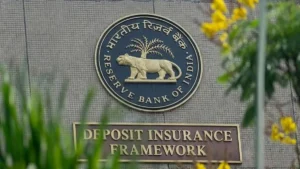Indian banks are set to experience a decline in their net interest margins (NIMs) by an estimated 10 basis points in the financial year 2025-26, as per a report by Fitch Ratings. This forecast follows the Reserve Bank of India’s (RBI) decision to lower the key policy rate by 25 basis points to 6.25% in February 2025. The rate cut marks the first such move in nearly five years, signaling the beginning of an easing cycle aimed at boosting economic activity. However, it also brings challenges for banks as lower lending rates are expected to squeeze margins, especially in the short term.
How Will the Rate Cut Affect Loans and Interest Margins?
The immediate impact of RBI’s rate cut will be felt on floating rate loans that are linked to external benchmarks. These include housing loans, small and medium enterprise (SME) loans, and other retail borrowing. As policy rates decline, new loans will be issued at lower interest rates, leading to a direct impact on banks’ earnings from interest. The margin compression will also extend to non-banking financial institutions (NBFIs) that operate in similar lending segments, such as urban housing and commercial loans. With increasing competition and declining yields, banks and financial institutions may face additional profitability challenges.
Why Do Deposits Take Longer to Adjust to Rate Cuts?
While loan rates typically adjust downwards quickly following a rate cut, deposit rates tend to lag in repricing. This delay creates a temporary squeeze on banks’ margins, as their cost of funds remains high while lending rates decline. Between April and September 2024, Indian banks maintained an average NIM of 3.5%, slightly lower than 3.6% in the previous year due to rising deposit costs. Fitch Ratings expects this trend to continue, with NIMs potentially settling around 3% in the long run. The decline in margins is partly attributed to slowing loan growth and reduced returns on interest-earning assets.
Will Liquidity Conditions Worsen the Margin Decline?
Liquidity in the banking system has remained high, crossing ₹3 trillion in January 2025 before settling above ₹2 trillion in mid-February. However, if liquidity tightens further, banks may struggle to pass on lower policy rates to depositors, exacerbating margin pressures. Fitch warns that banks could face faster-than-expected NIM compression if deposit costs remain high due to liquidity constraints. On the other hand, some relief may come from delayed implementation of higher expected credit loss provisions and deposit runoff rates, which might ease the margin pressure temporarily.
Looking Ahead: Can Banks Manage the Rate Cut Impact?
This decline in margins comes at a time when Indian banks are already navigating competition from alternative investment options, such as equities and mutual funds, which have drawn away deposit inflows. While the RBI’s rate cut aims to stimulate lending and economic growth, banks will need to carefully manage deposit rates, loan pricing, and liquidity to sustain profitability. The coming months will be crucial in determining how effectively banks balance these challenges while supporting credit expansion in a lower interest rate environment.
Key Highlights of Fitch Ratings’ Report on Indian Banks’ Margins
| Aspect | Details |
|---|---|
| Why in News? | Fitch Ratings projects a 10 basis points (bps) decline in Indian banks’ net interest margins (NIMs) in FY26 due to RBI’s rate cuts. |
| Rate Cut Impact | RBI reduced the key policy rate by 25 bps to 6.25% in February 2025, marking the first cut in nearly five years. |
| Loan Repricing | Floating rate loans, including housing and SME loans, will be affected immediately as new loans are issued at lower interest rates. |
| Deposit Lag Effect | Banks face short-term margin pressure since deposit rates adjust slower than lending rates. |
| Liquidity Status | Banking system liquidity peaked at ₹3 trillion in Jan 2025, remaining above ₹2 trillion in mid-February. |
| Long-Term Outlook | NIMs are expected to settle around 3% in the long run due to slower loan growth and lower yields. |
| Potential Risks | If liquidity tightens, banks may struggle to lower deposit costs, leading to a sharper-than-expected decline in margins. |



 RBI Slaps ₹62 Lakh Penalty on Kotak Mahi...
RBI Slaps ₹62 Lakh Penalty on Kotak Mahi...
 ADB commits $4.26 billion in sovereign l...
ADB commits $4.26 billion in sovereign l...
 RBI Board Sanctions Overhaul of Deposit ...
RBI Board Sanctions Overhaul of Deposit ...







